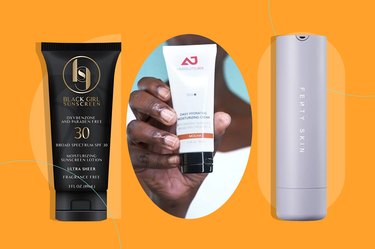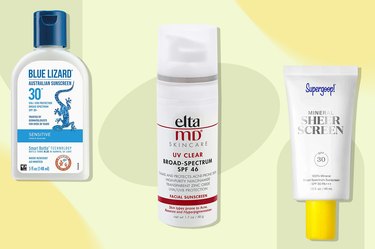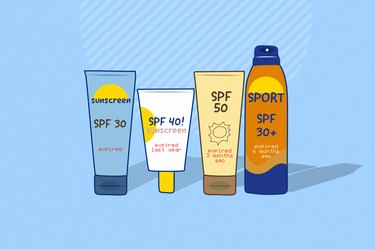
You might not think of your haircut as a time to be proactive about your health. But it can be an easy opportunity to stay one step ahead of skin cancer.
Up to 1 in 5 Americans will develop skin cancer in their lifetime, notes the American Academy of Dermatology. And rates of melanoma, the deadliest form of skin cancer, have increased in recent decades.
Video of the Day
Video of the Day
That may sound scary, but keep this in mind: "If skin cancer is detected at an early stage, when the cancer cells remain localized to the skin, it can often be cured with a simple procedure like a small skin surgery" or even a prescription cream, says Saira George, MD, associate professor of dermatology at the University of Texas MD Anderson Cancer Center in Sugar Land, Texas.
That's where your hairdresser comes in. In addition to taming your mane, they can be an ally when it comes to spotting growths on your scalp, ears or neck, dermatologists say.
How Your Hairdresser Can Help You Screen for Skin Cancer
Your scalp, neck and ears get a ton of exposure from the sun's UV rays every day. That puts them at high risk for potential skin cancers, according to the Mayo Clinic.
Problem is, "it's difficult to see these parts of your own body, so a new or unusual growth might go unnoticed for several months," Dr. George says.
Your hairdresser can help. "They're often the people who see our scalps most closely and regularly, and they can be the first to spot something growing in these sites," Dr. George explains.
And because they spend so much time looking at scalps, ears and necks each day, they often have a keen sense about whether a growth seems out of the ordinary, she adds.
You can bring up the topic casually at your next haircut. Before sitting down, let your hairdresser know you're trying to be more proactive about your skin health, and ask them to let you know if they notice any unusual moles or spots while they wash and cut your hair.
"If they point out something concerning, I'd recommend getting it checked out by a dermatologist," Dr. George says.
In other words: Your hairdresser isn't a skin expert — think of them as an additional tool in your arsenal of skin cancer prevention tactics, not as a substitute for good skin-care habits like wearing sunscreen (and sun-protective clothing) and seeing a dermatologist for an annual skin check (more on that in a bit).
How to Recognize Skin Cancer Warning Signs
What makes a skin growth or mole count as suspicious? "There are a couple of different types of skin cancer, and each type can look and behave differently," Dr. George says. "One feature they share is that they are growing and do so abnormally."
In other words, something about the growth may look different compared to other moles or growths you've had. To spot possible signs of melanoma, the American Cancer Society (ACS) recommends following the ABCDE rule. Check for:
- Asymmetry: One part of the growth doesn't match the other.
- Border: The edges appear irregular or blurred.
- Color: The color is irregular and includes shades of brown, black, pink, red, white or blue.
- Diameter: The spot is larger than a quarter inch (i.e. larger than a pencil eraser).
- Evolving: The growth's size, shape,or color is changing.
Other types of skin cancers, like basal or squamous cell carcinomas, may look different. According to the ACS, a good rule of thumb is to pay attention to any type of growths that seem new or unusual. These include:
- Growths or spots that don't look like others on your body
- Sores that don't heal
- Redness or swelling around a mole's border
- Color that spreads past a mole or spot to the surrounding skin
- Growths that are itchy, tender or painful
- Changes to a mole's surface, like oozing, scaliness, bleeding or the appearance of a lump or bump
Tips to Prevent Skin Cancer
The number-one rule of skin cancer protection is simple: "Don't overdo your sun exposure," Dr. George says.
Using a broad-spectrum sunscreen with SPF 30 or higher all over your body (including your ears and hair part) and seeking shade when the sun's rays are strongest (between 10 a.m. and 4 p.m.) can go a long way toward helping you do just that, according to the Skin Cancer Foundation. (And don't forget to reapply sunscreen every two hours, or sooner if you're sweating or in the water.)
And yes, you should wear sunscreen every day, even if you're not on the beach (and even when you're just riding in the car).
Sun-protective clothing is a good idea, too, and a wide-brimmed hat (ideally one with UPF, or ultraviolet protection factor) can serve as an extra safeguard for your head, especially if you have thinner hair. "It can do a lot to help protect areas like your scalp, ears and neck," Dr. George says.
Don't Forget to Schedule a Yearly Skin Check
One more important way to be proactive about your skin health? See your dermatologist once a year for a professional skin exam, recommends the Skin Cancer Foundation.
During the check, which will typically take about 10 minutes, the doctor will examine your skin from head to toe. (They likely won't examine your genitals unless you mention a spot or growth that concerns you.) They'll pay special focus to areas that are harder for you to check yourself, like your scalp, back, buttocks, toes and behind your ears.
Yearly exams give you and your dermatologist a baseline from which to judge any new growths that may eventually pop up, Dr. George says. If they see something suspicious, they can take a tissue sample of the mole to have it tested and determine whether it's cancerous.
Is this an emergency? If you are experiencing serious medical symptoms, please see the National Library of Medicine’s list of signs you need emergency medical attention or call 911.





